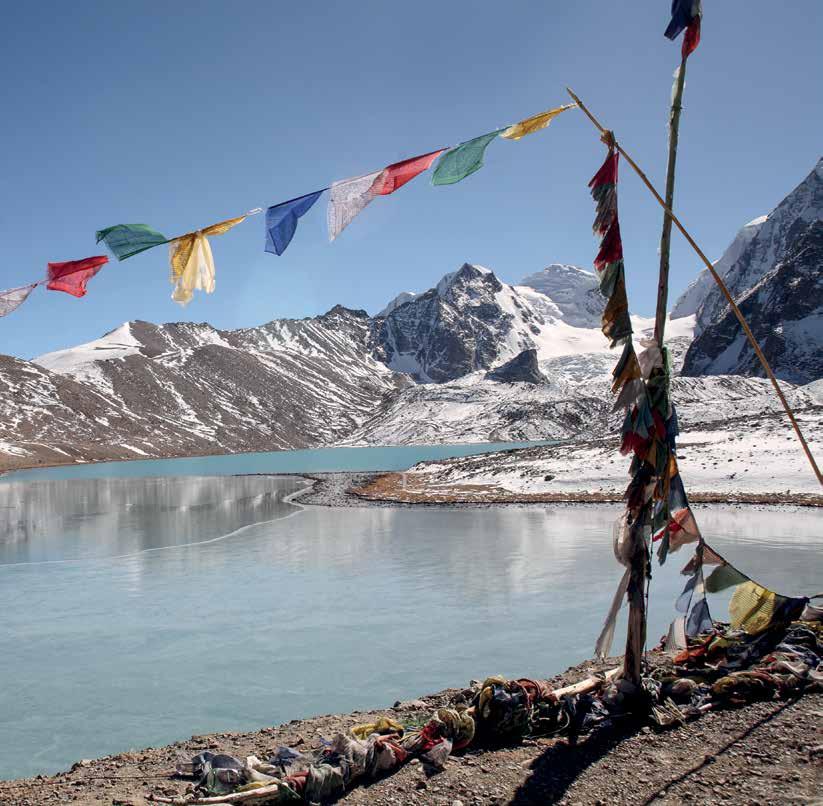
4 minute read
Sikkim
Kangchendzonga
R a n g i t
Advertisement
Nepali Lepcha
Khangchendzonga National Park
Nathu La
GANGTOK
In a remote corner of India, tucked away in the Eastern Himalayas, a Bungthing invokes his gods. From the time the first settlers came to this hidden land, this is a scene that has often played out in the forest, since the Lepcha worship nature as the ultimate form of creation. Beyond the world’s third-highest mountain, Kanchenjunga, at 8,686 m (28,497 ft.), extend the great Assam Himalayas that stretch from Sikkim to Arunachal Pradesh. The Kanchenjunga massif, also known to the rest of the world as "the Mountain of Gold", dominates the Singalila Range and is revered by virtually all people, regardless of which faith they follow. If ever there was a landscape that inspires awe it is certainly this endless and formidable treasure of the Eastern Himalayas. In many ancient Hindu texts it is called Indrakil, or "the Garden of Lord Indra". During the annual Pang Lhabsol festival, the lamas of Pemayangtse Monastery in West Sikkim invoke the blessings of Khangchendzonga, Sikkim’s guardian deity, to protect the land and take care of the people.
The rugged and impassable Assam Himalayas throw out two equally enormous spurs—the Singalila Range that separates Sikkim from Nepal to its west and the Chola Range that divides the state from the Chumbi Valley and Bhutan to the east. These
Nathu La, “the Listening Ears Pass”, at 4,310 m (14,140 ft.), a traditional part of the Old Silk Route, linked the plains of South Bengal to Lhasa in Tibet, traversing a distance of 563 km (349 mi.). Today manned by defence personnel, with no permanent human habitation and only an array of endangered species of animals for company, it opens for trade and visitors only during the summer months.

two mountain ranges form a gigantic amphitheatre, a maze of tangled interlacing ridges that rise range after range to the icy heights that are the perennial abode of the snows.
The Tibetan Plateau borders the North Sikkim Plateau, which, at an average altitude of 5,182 m (17,000 ft.), is home to some spectacular geographical features. The Kerang Bowl houses a glacier from where the Teesta River originates. Then there is the Gurudongmar Lake, which according to legend never completely freezes over, always leaving a small spot in the middle that is believed to be the blessing of revered saints like Guru Padmasambhava and Guru Nanak. This rain shadow area of the Kanchenjunga, a bleak and barren landscape given to extreme cold and blizzards, is even today the home of the nomadic herdsmen and their flocks of sheep intermingled with the shaggy yaks.

Moving eastward from Gangtok, past the Tsangu Lake, at an altitude of 4,310 m (14,140 ft.) lies Nathu La, one of the three traditional passes that connected Tibet and India. Even on a clear day, it is difficult to breathe here, and added to this is the wind chill factor. The pass was reopened after five decades for bilateral trade in 2006. Indian traders are allowed to set up shop a few kilometres inside China and, similarly, the Chinese can come down to Sherathang. Beyond lies the Chumbi Valley, where the boundaries of India, China and Bhutan meet.

It is believed that in ancient times the Lepcha, who are of Mongolian racial stock, resided in Southeast China. Their search for new lands brought them to the base of the Kanchenjunga. They recognized this to be the land of their quest; Sikkim was their own Nye-Mayelyang, “a hidden heaven on earth”, where the sacred rivers Rangit (Re-Nye) and Teesta (Tashi-Drag) flowed through the valleys. The Tibetan name for Sikkim is Denjong, or "Valley of Rice", while the Bhutia call it Beyul Demazon, or "Hidden Valley of Rice".
Da-chos, or prayer flags, breezily paint the landscape of Sikkim, particularly in places of pilgrimage, where they are strung out gaily, carrying luck in every direction as though riding an airy horse.
facing page The Gurudongmar Lake, seen here in all its pristine beauty at the height of winter, is bedecked with prayer flags in summer when the snow recedes.
Dipti Bhalla Verma, cofounder of the production company KaleidoIndia, has made numerous films about the people, natural heritage and armed forces of India. She is also coauthor and photographer of the books Ocean to Sky: India from the Air, Tamil Nadu and the Northeast Trilogy. She is an alumna of Miranda House, Delhi, the Film and Television Institute of India, and the Australian Film and Television School.
Shiv Kunal Verma is the author or coauthor of more than a dozen books, including the highly acclaimed Northeast Trilogy, The Long Road to Siachen and 1962: The War That Wasn’t. As the cofounder of KaleidoIndia, he has produced over fifty films. Among his many distinguished films on the Indian Armed Forces, The Standard Bearers, a film on the National Defence Academy, is considered an all-time classic. Educated at the Doon School and Madras Christian College, he currently holds the prestigious Chair of Excellence at the United Services Institute.
PHOTOGRAPHY Life and Culture in Northeast India Dipti Bhalla Verma • Shiv Kunal Verma
260 pages, 318 photographs & 12 maps 9 x 11” (228.6 x 280 mm), hc ISBN: 978-93-85360-25-1 ₹2950 | $65 | £50 Sept. 2020 • World rights
OTHER TITLES OF INTEREST
WATER TREASURES OF THE HIMALAYAS
Serge Verliat and Jean Philippe
MOULDING THE VOID
Mother in the Making Peter Bjørn Franceschi • with translations by Minati Kar


